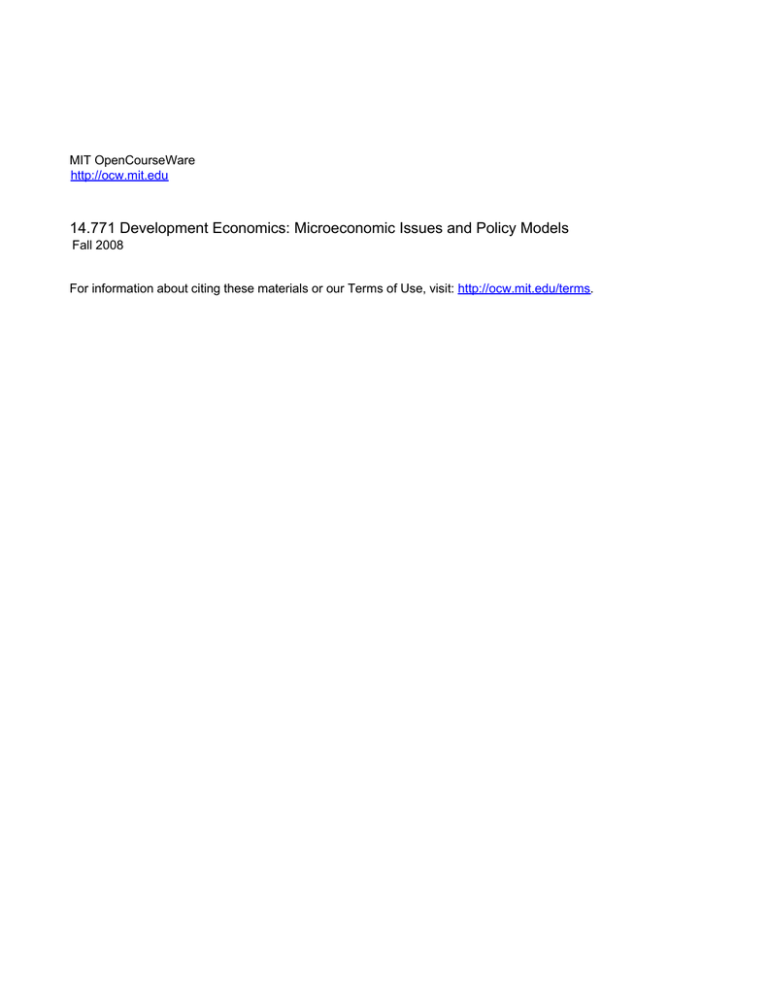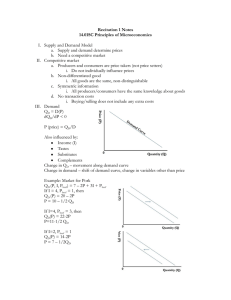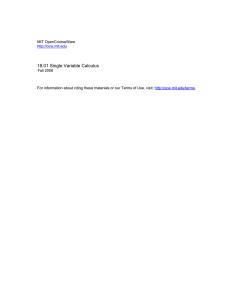14.771 Development Economics: Microeconomic Issues and Policy Models MIT OpenCourseWare 8 Fall 200
advertisement

MIT OpenCourseWare http://ocw.mit.edu 14.771 Development Economics: Microeconomic Issues and Policy Models Fall 2008 For information about citing these materials or our Terms of Use, visit: http://ocw.mit.edu/terms. Development Economics Fall 2008 MIT 14.771 Questions on Required Reading #1: Dasgupta and Ray (1986), Srinivasan (1994) Read in details Das Gupta and Ray article and TN Srinivasan’s review of Das Gupta’s book. The following questions will help you make sure you are following the authors’ argument. 1) The capacity curve relates the work capacity to the employment income: a. Explain the shape of the capacity curve in the figure 1 below. Two wage curves have been drawn (v1 and v3). Plot the minimum piece rate at which the worker has some non-trivial capacity to work. Let’s call this minimum rate v0. b. Plot the individual labor supply as a function of the piece rate. Discuss what happens to the individual labor supply at v0. c. Imagine an economy with a population of identical people whose capacity curve is that of figure 1. Describe the equilibrium if the labor demand intersect the labor supply at v<v0, v=v0 and v>v0. Identify in which case we will have involuntary unemployment. d. Assume now that we have landed and landless individuals whose capacity curves are represented in figure 2. Define v0 for the landless and v0L for the landed. Which one is larger? Why? Is the labor market increasing or decreasing the existing inequality in assets? How? e. Imagine that a little bit of land was given to the landless. Show that the equilibrium piece rate would have to fall for a stable demand. f. Show that if there is unemployment before and after the change in nonlabor income, the total income (non-labor and labor income) of employed labor must fall as well. Why is this? g. Show that if there is a mix of people with nonlabor income and some without nonlabor income, the individuals with nonlabor income will always do better than the individuals with no such income. 2) Assuming we have a capacity curve that has some convexity for each individual in the economy. Does this guarantee the existence of a poverty trap at the economy-wide level? Why is it that, in this case, the poor are not malnourished and unable to work? 3) Can long-term contracts (such as indentured servitude) allow a worker to offer his labor power at a lower wage? Why would this strategy work? Why might it not be feasible? 4) What is the effect of a minimum wage in the Dasgupta-Ray model? Under what condition is it welfare improving? Under what condition is it not? Explain the rationale behind this result. 5) What is the crux of Srinivasan’s argument in his critics of Das Gupta’s book? Is it theoretical or empirical? How would we go about assessing who is right? Figure 1: Capacity curve and wages Work capacity v1 v3 Employment income Figure 2: Capacity curve by land status Work capacity landed landless Employment income



